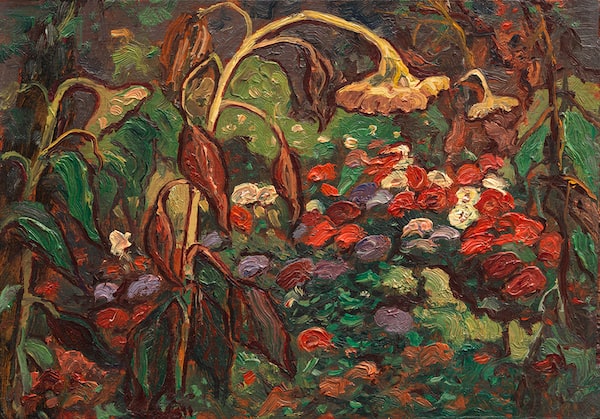If you go to the Vancouver Art Gallery this weekend, you will see 10 oil sketches that have been in the collection for more than nine years, shown to the public for the first time. And with new information. Instead of being credited to Group of Seven member J.E.H. MacDonald, the listed artist is “unknown” and titles that once read “sketch for” now say “sketch after.” The reason: They’re not warm-up pieces he made for his famous works; they’re copies by someone else. And it took years for the gallery to go public about that.
For the first time since announcing what became a controversial donation in 2015, the VAG is laying out researchers’ findings about the sketches, none of which are real MacDonalds. They use paints that didn’t exist in MacDonald’s lifetime. Other clues include: the use of boards unlike the ones MacDonald painted on, and signatures purportedly by his son, Thoreau, that are spelled four different ways.
In “J.E.H. MacDonald? A Tangled Garden,” an exhibition opening this Saturday, the VAG will give the public a closer look at how the fakes were found. Here are highlights about some of the artworks from the exhibit, including from reports, videos and a forthcoming book on the painter.

Sketch after The Tangled Garden
Telltale clue: Two of the paint types didn’t exist when MacDonald was alive
Phthalocyanine green (Pigment Green 7) was discovered in 1935, and pigment production began in 1936, four years after MacDonald’s death. The rutile form of titanium white was commercially introduced as a white pigment in Germany in 1938 and in the United States in 1942. Phthalocyanine green and rutile titanium white were found in multiple samples from the sketch. ... The use of multiple anachronistic pigments in various parts of the composition showed that J.E.H. MacDonald did not paint this sketch.
— From J.E.H. MacDonald Up Close: The Artist’s Materials and Techniques by Kate Helwig and Alison Douglas

Untitled (Batchawana Rapids)
Telltale clue: A typo on the back
In this photograph of the back of Untitled (Batchawana Rapids), MacDonald has been misspelled ‘MacDnald.’
— From the Vancouver Art Gallery’s exhibit text

Sketch after The Wild River
Telltale clue: A missing canoeist
Looking at the purported sketch for The Wild River, Charles Hill [former curator at the National Gallery of Canada] was aware that MacDonald did not typically include figures in his original sketches, but added them later to the final canvas. Here he noted that the figure in the final painting shown portaging a canoe is missing in the sketch, but the shape of the canoe remains, now having the appearance of a log. This suggested to him that whoever painted the work might have been working from a low-resolution reproduction, causing them to miss seeing the figure and thus mistaking the shape of the canoe for a log.
— From the exhibit

Sketch after Falls, Montreal River
Telltale clue: A missing riverbank
This is another instance in which Charles Hill’s knowledge of MacDonald’s oeuvre enabled him to compare a little-known sketch for Falls, Montreal River, at the University of Toronto, with the final painting in the Art Gallery of Ontario as well as with the contested sketch above. He noted that MacDonald changed the final composition from his original sketch, eliminating the riverbank in the bottom left to create a more dramatic continuous diagonal flow of water across the composition. Once again, this suggested to him that the purported sketch was done after the final composition, not in situ in the landscape.
— From the exhibit
Sketch after Mist Fantasy
Telltale clue: Trees and clouds that shouldn’t be there
Charles Hill compared the contested sketch above with both the final painting, Mist Fantasy, Northland, at the Art Gallery of Ontario and a known sketch, Mist Fantasy, Sound River, Algoma, in the National Gallery of Canada (NGC). As in other cases, he noted significant changes in the composition from the well-authenticated sketch at the NGC and the final painting, including the addition of trees in the background and the extension of the clouds so that they rise in dramatic wisps to the left and right.
— From the exhibit
Sketch after The Elements
Telltale clue: The sky is too bright
Hill was aware that it has long been known that the painting The Elements, as it exists now in the Art Gallery of Ontario, had been changed by the artist after its first public exhibition. ... A photograph taken of the painting The Elements, sourced from an Ontario Society of Artist’s exhibition catalogue from 1916, reveals that MacDonald significantly repainted the work after that exhibition, most notably, brightening the sky in the upper-left corner. Hill argued that because the purported sketch reflects the revised composition and not the original, it was likely painted from the final state of the painting and not as a sketch for it.
— From the exhibit
The person who painted this was looking at the canvas as it existed after 1926 with the changes in the sky.
— Charles Hill in an exhibition video.
With a report from Marsha Lederman



